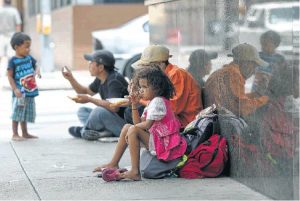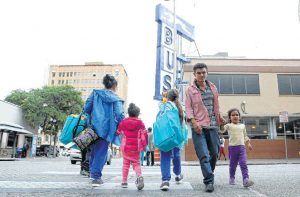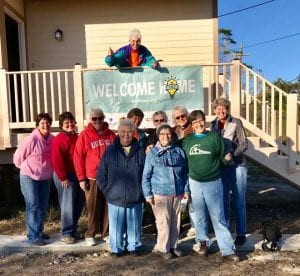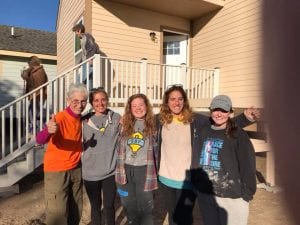Witness Ursuline Efforts in
Diversity, Equity and Inclusion

Our Better Path Forward Together is a blueprint for building an anti-racist and fully inclusive community, a goal to which we are deeply committed. We realistically divided our plan into short-term, mid-term and long-term goals. And we promised to update you on our progress, which has been considerable. We offer you this report as we continue the work of building a just environment for every person in our community.
In the five months since our work on Diversity, Equity & Inclusion became our focus, the following has been completed or is in progress:
*The Student/Parent Handbook was completely updated and reviewed by legal counsel. Language was updated in all areas, including what constitutes harassment and bullying. The steps in the process of adjudicating disciplinary issues also were clarified.
*We have interviewed candidates for the new senior position of Director of Diversity, Equity & Inclusion and have identified finalists. The search process is on-going.
*We held meetings via Zoom with all of our students and parents by grade level. The conversations allowed us, the Administrative Team and the DEI Team, to check in with students and gather their input.
*We have published our DEI Mission Statement and other related information on our web page devoted to DEI work.
*Faculty and Staff have taken part in three Professional Development sessions on anti-racism, equity and inclusion. These sessions are facilitated by Dwight Vidale, Director of Institutional Equity and Belonging at Collegiate School. Additional sessions are scheduled.
*Our DEI team conducted a six-week summer workshop for interested faculty that explored challenges to equity and the difficult conversations that will propel our movement forward.
*We introduced units from Pollyanna, a Middle School curriculum that helps students learn about race and allows them to explore diversity.
*Our Administration and DEI teams have met 9 times with Dr. Donna Andrade, Dean of Mission & Ministry at Fairfield Prep and consultant to all Jesuit schools in the US on issues of Diversity and Inclusion. Our work has included developing a structure that will bring all stakeholders to the table once our DEI Director is hired.
*Our DEI team has created affinity groups that encourage and facilitate conversation and belonging.
A major new initiative is the formal multi-year review of our curriculum. Although this initiative is in its infancy, the appointment of our first ever Scholar-in-Residence has already begun to enhance the curriculum in important ways. As we hope you read in the separate announcement, Dr. Adria Armbrister ’94 has already partnered with our global scholars, as well as our Social Studies and English departments and our Personal Development program. We are honored that she is sharing her outstanding experience as an international project manager and educator to heighten the critical thinking around equity and justice. Dr. Armbrister’s tenure this year will help Ursuline as we strive for a more inclusive academic experience.
When we created a Better Path Forward Together last summer, we also created plans for programs in which we would work specifically with students to help us create an anti-racist and equitable environment for all of them. We have several programs scheduled. They include:
*A workshop for our sophomores and another for our freshmen that will be facilitated by older students. One cohort already has had the sensitivity training entitled “Intent vs. Impact” and the second cohort will have it once we are back in session in January.
*Also in January, all sophomores will have a workshop on the subject of “The N-Word” that will be facilitated by a consultant on Diversity, Equity and Inclusion work. We are determined to do these workshops with each cohort in person, because we believe it is more valuable when discussions can be done this way.
Nonetheless we have not been deterred by conditions imposed by the pandemic. As we present to you this state-of-the-school report, we are aware that this challenging work is constant and continual. Our goal is to make Ursuline a truly just, inclusive and equitable community where each community member feels a sense of belonging. Our commitment is unwavering.
Sincerely,
Eileen Davidson, President
Rosemary M. Beirne, Principal
The Red Sand Project
Molly Gochman first launched Red Sand Project in 2014, after realizing the depths to which slavery continues to be a contemporary reality. Globally, an estimated 40.3 million individuals live in slavery, whether in forced marriages, forced labor, or for sexual exploitation. Molly recognized that to begin finding a solution to such a widespread challenge, increased public awareness and engagement would be essential. She initiated the first Red Sand Project action in Miami, where she filled the cracks of sidewalks in and around the Art Basel Miami Beach pavilion with red sand. The approach was symbolic, with the grains of sand representing those individuals who fall through the cracks—whether the cracks of our social, economic, and political systems or those of our personal consciousness.
To expand the reach of the project, Molly launched a website offering Red Sand Project toolkits, which include packets of red sand and information about slavery and trafficking in the U.S. and across the world, giving participants a way to physically engage with the cause and to build discussions around the action. Today, Red Sand Project actions have been done in all 50 states and in 70 countries, with more than one million participants.
This spring Sister Mary Dostal and Sister Pat Funderhide participated in the Red Sand Project opportunity offered by Grace United 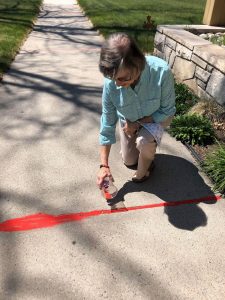 Methodist Church in Billings, Montana. This event helps to raise awareness about human trafficking. The red sand is poured into sidewalk cracks as a symbol of the victims of human trafficking and how they fall into the cracks of society. In order to provide for social distancing, guests were invited to come to Grace United on their own time, grab a packet of sand, and fill in some sidewalk cracks. There was also a display of signs that gave various statistics on human trafficking.
Methodist Church in Billings, Montana. This event helps to raise awareness about human trafficking. The red sand is poured into sidewalk cracks as a symbol of the victims of human trafficking and how they fall into the cracks of society. In order to provide for social distancing, guests were invited to come to Grace United on their own time, grab a packet of sand, and fill in some sidewalk cracks. There was also a display of signs that gave various statistics on human trafficking.
Ursulines are called to be Artisans of Change and periodically it is good for us to reflect on just what we, our colleagues and associates are doing in response to that call. Be inspired by these stories:
Artisans of Change Vol. 1 Issue 1
Artisans of Change Vol. 1 Issue 2
Artisans of Change Vol. 1 Issue 3
Artisans of Change Vol. 1 Issue 4
Artisans of Change Vol. 1 Issue 5
Artisans of Change Vol. 1 Issue 6
Artisans of Change Vol. 1 Issue 7
Reflection on Serving in McAllen, Texas
During the week of June 24th I had the privilege of serving with Srs. Maria Teresa DeLlano and Elisa Ryan along with five young women in McAllen, Texas. We began our experience, on Sunday, June 23rd, by exploring the town of Progresso which is right on the border with Mexico. As we visited we had the opportunity to go to the International Bridge and see some of the border wall. It was a rather daunting sight with multiple layers of razor sharp barbed wire all over it. We could see the Rio Grande River in the distance. At our group orientation messages were shared that had been received from our sisters and some school administrators. It was heartwarming to read these messages and know that people were indeed praying for the success of this trip. There was great energy in the group of women gathered. We were eight in number with three juniors in college, two seniors in high school and three Ursuline sisters. 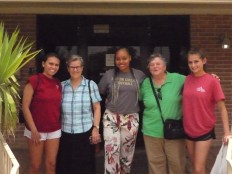
On Monday, June 24th we began our work at the Catholic Charities Humanitarian Respite Center where we welcomed some 300 – 450 travelers who are beginning a new life in the USA. They had been released from the detention center where the conditions were deplorable. Belts, hair ties and shoe laces were confiscated as they were considered potentially harmful. Each family arrived with a manila envelope with, “Please help me, I do not speak English. What bus do I take? Thank you for your help.” At the Respite Center they were connected with their family members or sponsors and transportation was arranged.
There were so many women with small children and there were people everywhere. After a brief orientation we began work. Not always sure of what we were doing we just kept on doing. We helped serve breakfast and lunch, prepared a huge supply of fresh vegetables, distributed clothing, two went to Sam’s Club to purchase some badly needed supplies and we smiled a lot. Two of us even took a mother and her 3 year old daughter to the medical clinic for treatment because of an infected cut and a rash from not bathing and then went to get the prescriptions she needed. This particular left El Salvador with her five children but only four were released with her as the oldest was nineteen and considered an adult. She has more than likely been sent back to El Salvador. .As we worked in the many areas we found ourselves communicating with smiles and simple words as our Spanish was limited compared to the need.
The lunch shifts were very hectic due to the number of people who needed food, but there were always travelers there to help us serve the lunch. They were all very noble, serving the others before grabbing their own, even though they had been working already to help with the food. One of our travelers was cleaning and tidying and when asked where her shoes were, she humbly responded, “No tengo zapatos.” In a manner of minutes, she had shoes as one of our volunteers made sure that she had what she needed especially after she had been so helpful during the day. Such simple actions cause one to be humbled by all that is happening.
Each day was a little different at the Catholic Charities Humanitarian Respite Center. One day when we arrived at the Center we were surprised when we did not see too many people in the reception area. When we entered the clothing area, we realized that everyone was just in the inner area. We immediately got to work, preparing breakfast, distributing clothing and whatever else needed to be done. Upon entering the clothing area, we realized that everything was totally mixed up and we needed to shut the station down for a few minutes to reorganize the clothing which was everywhere. In less than 15 minutes we were all set to begin the work of welcoming our travelers with a change of clothes and shoes if needed. The kitchen crew did an amazing job feeding the many hungry travelers and had the experience of not being sure if the promised lunch donation was really going to arrive.
After we returned home from dinner each day we had a reflection period where we shared on the days experiences. One night we focused on where we saw/met Jesus today. The responses were often in the faces of the men, women and children that we had encountered during our day. Each one shared how they saw Jesus in the faces of those we served and in the faces of many of the other volunteers. Even though we were not able to take photos the faces of the travelers I believe they will forever be imprinted in our hearts and minds.
One evening we had the opportunity to meet Sr. Norma Pimentel, a Sister with the Missionaries of Jesus. She has served as Executive Director of Catholic Charities of the Rio Grande Valley for over 12 years, she oversees the charitable arm of the Diocese of Brownsville, providing oversight of the different ministries and services in the areas of the Rio Grande Valley through emergency assistance, homelessness prevention, disaster relief, clinical counseling, pregnancy care, food program(s), and the Humanitarian Respite Center. It was a very special meeting as she has done so much for those who are in the process of assimilating into the United States.
Describing the Catholic Charities Humanitarian Respite Center does not do it justice. You need to be there to truly experience the obstacles that the travelers have to endure. Looking into the eyes of the sick, scared, hopeful, and very grateful travelers, you are transformed forever. Through our experience this week, we have seen how immigrant people are beautifully able to rise above all differences and unite as brothers and sisters.
This experience has deeply impacted my life and has heightened my awareness of what these travelers have to endure. It was truly a humbling experience and I learned so much from it. I am so grateful that I was able to be part of this project.
Serviam Alive Today
Sister Karen Schwane writes from her volunteering with the migrants pouring into San Antonio:
“It is something else at the bus station these days. Thank God for the City pitching in; people are getting prepared food to eat. They are showing up from Dilley, as usual but also Eagle Pass, McAllen, Del Rio. I was busy every minute today. The only chance to sit was making the bus schedule with parents. There used to be time and volunteers to take those who wished to the park or to see the cathedral. Now that is impossible. My coordinator told me that 220 stayed in the church overnight, last night.”
The news clip below will give you some more details about the needs in San Antonio right now in May 2019.
San Antonio Migrant Report
Six-year-old Kimberly Gabriela Carcamo waits outside San Antonio’s resource center with her father, Santos Gabriel Carcamo, 58. They’re from Honduras.
Migrants make their way between the Greyhound Station and the San Antonio Resource Center. The center, which opened March 30, provides humanitarian help to the mostly Central American migrants.

